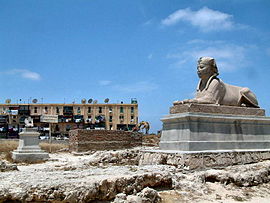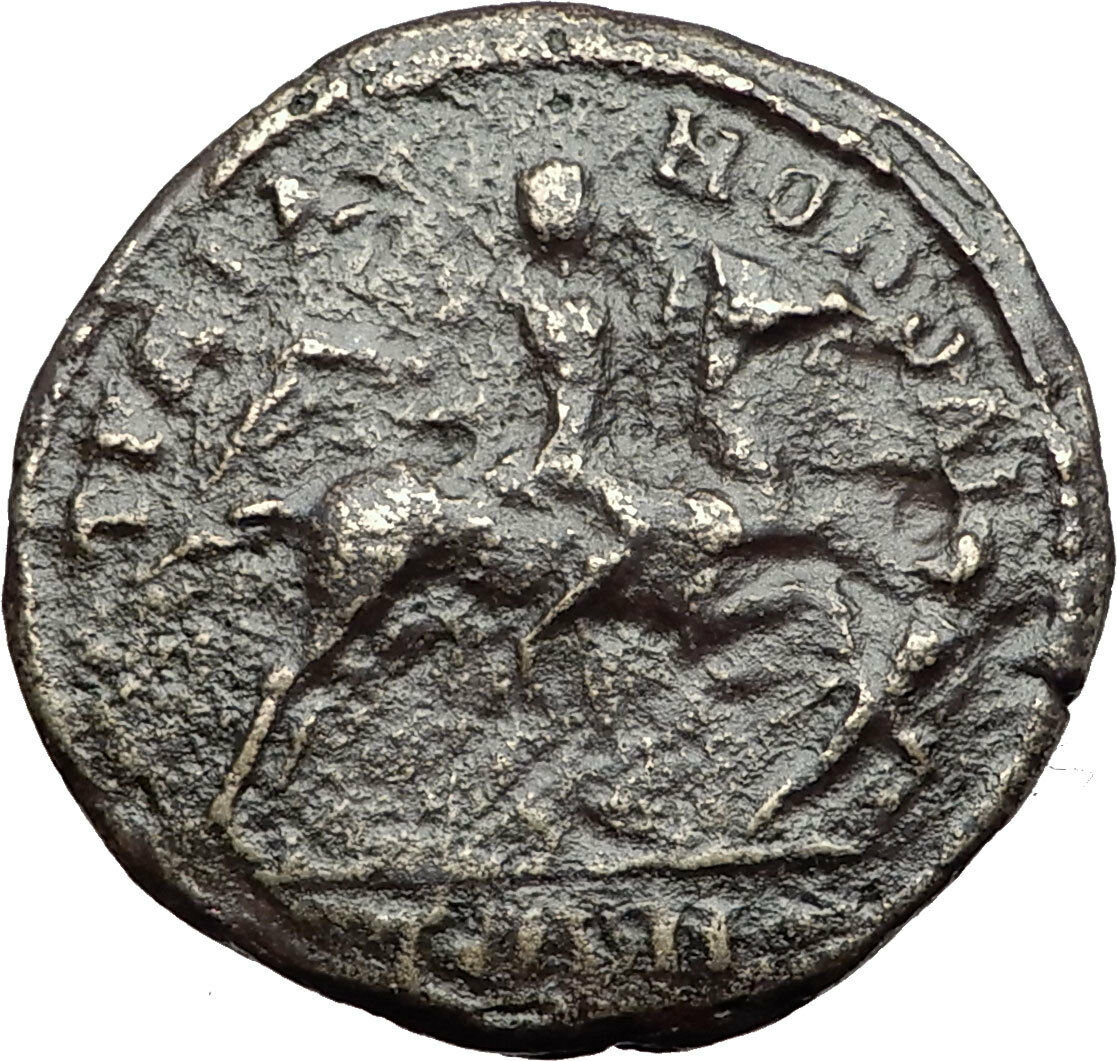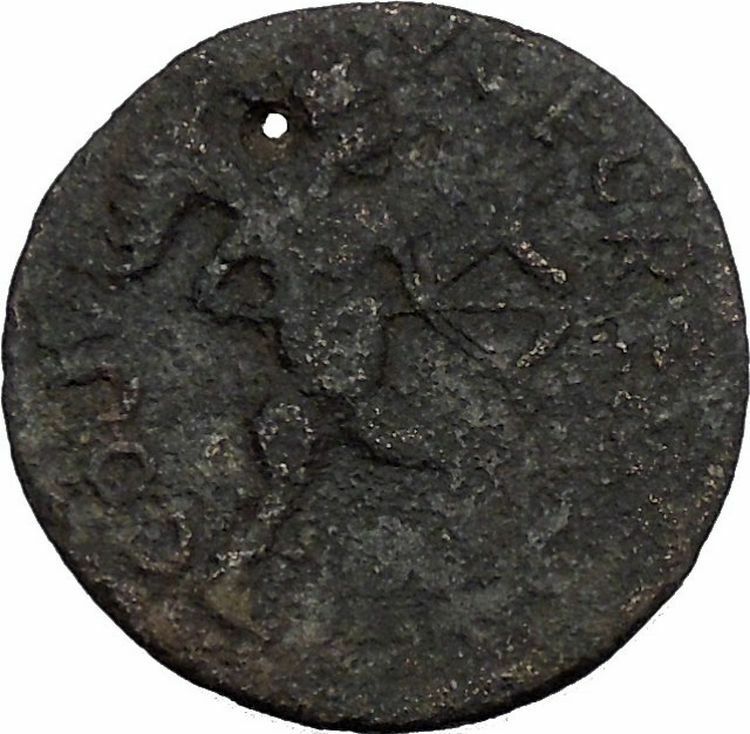|
Carus –
Roman Emperor: 282-283 A.D. –
Divus Carus “Deification / Consecration” Issue
Billon Tetradrachm 20mm (903 grams) of
Alexandria in
Egypt Struck 283 A.D.
Reference: Dattari 5571; Emmett 3995; Oxford 4733; Cologne 3168
ΘЄW KAPW CЄB, Laureate head right.
ΑΦΙЄΡWCIC, Flaming, garlanded altar on base; in upper field to left, a star
symbolizing the deified Carus.
One of the few Alexandrian coins issued for a
consecrated emperor.
You are bidding on the exact
item pictured, provided with a Certificate of Authenticity and Lifetime
Guarantee of Authenticity.
Consecration Ceremony in Ancient Rome

The
ceremony of consecration was very solemn and imposing. After the body had
been clothed in the habiliments of death, it was placed on a bed of ivory; young
men, chosen from the equestrian order, bore it on their shoulders to the pile.
The Rogus, or Funeral Pile, is described by Dion, as “a
structure in the form of a turret, with three stories, of ivory and gold, and
ornamented with statues.” Herodian describes it as a mass of quadrangular shape,
filled at the bottom with combustibles, on which again a second tier was placed
of similar form and appearance, but narrower and furnished with openings; to
this a third and a fourth were added, each gradually diminishing in size, till
the whole resembled a watch-tower.”
The corpse being then introduced into the second layer or
story, it was surrounded with aromatics and precious balms. The usual ceremonies
being completed, a torch was applied, and the mass was consumed. After this
apotheosis, the deceased emperor or empress had temples, altars, and priests
dedicated to his or her honour, and the same worship was paid to the defunct, as
paganism rendered to its gods and goddesses; whilst the Augusti, or Augustae,
were thenceforth called DIVI and DIVAE. The form of the rogus, described as
above by ancient writers, is brought to our view, with remarkable clearness, on
numerous coins. “Amongst these,” adds Eckhel, “there is one which I am told,
stands conspicuous. This is a Julia Maesa, discovered at Rome; respecting which
its then possessor, Viscount Ennius, a renowned antiquary, wrote to Garampi,
papal nuncio at Vienna, that it is so well executed, and in such high
preservation, that in the second layer of the funeral pile, the corpse of the
empress is seen recumbent on a bed; a minute particular, never before
distinguished in the monetal representation of these funeral structures.”
Alexandria was founded
by
Alexander the Great
in April 331 BC as
Ἀλεξάνδρεια (Alexándreia).
Alexander’s
chief architect
for the project was
Dinocrates
. Alexandria was intended to
supersede Naucratis
as a
Hellenistic
center in Egypt, and to be the link
between Greece and the rich
Nile Valley. An Egyptian city,
Rhakotis
, already existed on the shore, and
later gave its name to Alexandria in the
Egyptian language
(Egyptian *Raˁ-Ḳāṭit,
written rˁ-ḳṭy.t, ‘That which is built up’). It continued to exist as the
Egyptian quarter of the city. A few months after the foundation, Alexander left
Egypt and never returned to his city. After Alexander’s departure, his viceroy,
Cleomenes
, continued the expansion. Following a
struggle with the other successors of Alexander, his general
Ptolemy
succeeded in bringing Alexander’s body
to Alexandria.

Alexandria, sphinx made of
pink granite
,
Ptolemaic
.
Although Cleomenes was mainly in charge of overseeing Alexandria’s continuous
development, the Heptastadion and the mainland quarters seem to have been
primarily Ptolemaic work. Inheriting the trade of ruined
Tyre
and becoming the centre of the new
commerce between Europe and the
Arabian
and Indian East, the city grew in less
than a generation to be larger than
Carthage
. In a century, Alexandria had become
the largest city in the world and, for some centuries more, was second only to
Rome. It became Egypt’s main Greek city, with
Greek people
from diverse backgrounds.
Alexandria was not only a centre of
Hellenism
, but was also home to the largest
Jewish community in the world. The
Septuagint
, a Greek translation of the
Hebrew Bible
, was produced there. The early
Ptolemies kept it in order and fostered the development of its museum into the
leading Hellenistic center of learning (Library
of Alexandria), but were careful to maintain the distinction of its
population’s three largest ethnicities: Greek, Jewish, and
Egyptian
. From this division arose much of the
later turbulence, which began to manifest itself under
Ptolemy Philopater
who reigned from 221–204 BC.
The reign of
Ptolemy VIII Physcon
from 144–116 BC was marked
by purges and civil warfare.
The city passed formally under Roman jurisdiction in 80 BC, according to the
will of
Ptolemy Alexander
, but only after it had been
under Roman influence for more than a hundred years. It was captured by
Julius Caesar
in 47 BC during a Roman
intervention in the domestic civil war between king
Ptolemy XIII
and his advisers, and the fabled
queen
Cleopatra VII
. It was finally captured by
Octavian
, future
emperor
Augustus on 1 August 30 BC, with the
name of the month later being changed to August to commemorate his
victory.
In AD 115, large parts of Alexandria were destroyed during the
Kitos War
, which gave
Hadrian
and his architect,
Decriannus
, an opportunity to rebuild it. In
215, the
emperor
Caracalla
visited the city and, because of some
insulting satires
that the inhabitants had directed at
him, abruptly commanded his troops to
put to death
all youths capable of bearing
arms. On 21 July 365, Alexandria was devastated by a
tsunami
(365
Crete earthquake),
an event still annually commemorated 17 hundred years later as a “day of
horror.”
In the late 4th century, persecution of
pagans
by newly Christian Romans had reached
new levels of intensity. In 391, the Patriarch
Theophilus
destroyed all pagan temples in
Alexandria under orders from Emperor
Theodosius I
. The
Brucheum
and Jewish quarters were desolate in
the 5th century. On the mainland, life seemed to have centred in the vicinity of
the Serapeum and
Caesareum
, both of which became
Christian churches
. The
Pharos
and Heptastadium quarters,
however, remained populous and were left intact.
In 619, Alexandria
fell
to the
Sassanid Persians
. Although the
Byzantine Emperor
Heraclius
recovered it in 629, in 641 the Arabs
under the general
Amr ibn al-As
captured it during the
Muslim conquest of Egypt
, after a siege that
lasted 14 months.
Marcus Aurelius Carus (c. 230 – late July/early
August, 283) was a
Roman
Emperor
(282-283). During his short reign, Carus tried to follow the path of
restoration of the empire strength marked by
Aurelian
and Probus
. His
sons Carinus
and Numerian
formed, with Carus, a short lived dynasty, which granted further stability to a
resurgent empire. He also had a daughter Aurelia Paulina.
//
Biography
Carus, whose name before the accession may have been Marcus
Numerius Carus, was born, probably, at
Narbo (modern
Narbonne)
in Gaul,[1]
but was educated at Rome
. He was a
senator
,
and had filled various civil and military posts before he was appointed
prefect
of
the
Praetorian Guard
by the emperor Probus in 282. After the murder of Probus at
Sirmium
,
Carus was proclaimed emperor by the soldiers. Although Carus severely avenged
the death of Probus, he was himself suspected of having been an accessory to the
deed. He does not seem to have returned to Rome after his accession, but
contented himself with an announcement of the fact to the Senate.
Bestowing the title of
Caesar
upon his sons Carinus and Numerian, he left Carinus in charge of the
western portion of the empire, and took Numerian with him on the expedition
against the
Persians
which had been contemplated by Probus. Having defeated the
Quadi
and
Sarmatians
on the Danube
,
Carus proceeded through
Thrace
and
Asia Minor
, annexed
Mesopotamia
, pressed on to
Seleucia
and
Ctesiphon
,
and carried his arms beyond the
Tigris
. The
Sassanid Emperor
Bahram II
limited by internal opposition, could not effectively defend his territory. For
his victories, which avenged all the previous defeats suffered by the Romans
against the Sassanids, Carus received the title of Persicus Maximus.
Carus hopes of further conquest were cut short by his death. One day, after a
violent storm, it was announced that he was dead. His death was variously
attributed to disease, the effects of
lightning
,
or a wound received in a campaign against the
Persians
. The facts that he was leading a victorious campaign, and that his
son Numerian succeeded him without opposition, suggest that his death may have
been due to natural causes.
|










